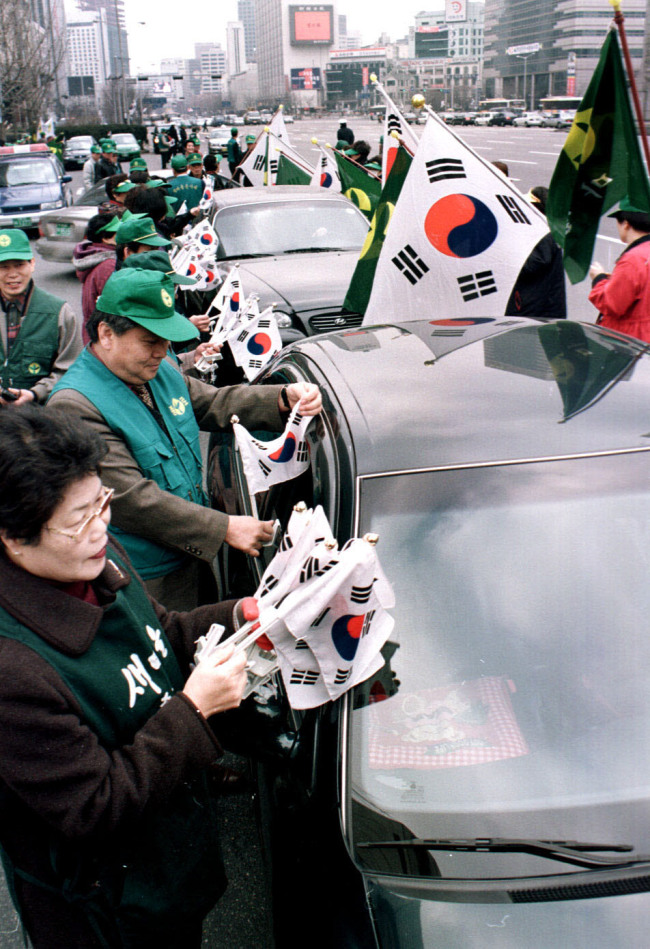The war of words is heating up between the government and Seoul City over the Ministry of Patriots and Veterans Affairs’ plans to raise the national flag at the heart of downtown in commemoration of the 70th anniversary of the country’s liberation from Japan this year.
The tit-for-tat over how long and where the giant flag pole should be installed represents a fresh standoff between the conservative government of President Park Geun-hye and the progressive municipality run by Mayor Park Won-soon.
The tit-for-tat over how long and where the giant flag pole should be installed represents a fresh standoff between the conservative government of President Park Geun-hye and the progressive municipality run by Mayor Park Won-soon.

The Park administration has been campaigning for active use of the national flag as part of its efforts to promote patriotism, a move that has often met with criticism for wasting tax money or forcing loyalty. It has been creating some 385 “Taegeukgi” streets across the country in cooperation with local governments.
Last June, the city broadly agreed to help the ministry run up the Taegeukgi at Gwanghwamun Plaza through a waterscreen projection, and the sides have since held several meetings to hammer out its design, the height of the pole, duration and other details.
While the ministry wanted the flag to remain in the same location until next Liberation Day on Aug. 15, the city suggested that it stay at the square until the end of the year and then be relocated to a nearby park, citing perceived public inconveniences and resistance from a citizens’ panel that calls the plan “antiquated.”
With both sides refusing to budge, the Office for Government Policy Coordination under the prime minister stepped in to play as arbitrator, but to little avail. On Nov. 23, Seoul City delivered its final decision to allow the flag to be temporarily erected at the park only, and the ministry should look for a state-owned space for its permanent installation.
“We strongly regret that this quasi-government project, which is endorsed by the majority of the population and linked with the nation’s identity, cannot take off because of the opposition of a municipality that only has the license to use the plaza,” Kim Joo-yong, director general for burial and commemoration at the ministry, said at a news conference on Tuesday.
He noted that in a poll commissioned to survey firm Research & Research in October, 87.3 percent of the 1,000 respondents were in favor of the scheme.
“We will explore all possible administrative measures to push ahead with the plan, including referring the issue to the Committee for Administrative Consultation and Coordination tasked with resolving conflicts between the central and local governments.”
The city, for its part, blasted the ministry’s rigidity and insistence on “impossible” proposals given the tight schedule, saying it instead offered to extend the period until March 2017 if placed at the park.
In contrast to the ministry’s argument, the memorandum of understanding did not stipulate the flag’s permanent stationing. The poll results aside, the ministry also took flak for belatedly yet rashly initiating the 400 million won ($343,500) program when most other commemoration projects have already kicked off and finished in time for the Aug. 15 anniversary.
“The citizens’ panel, too, acknowledged the program’s significance but assessed that if the flag continues to stay there long after the anniversary, it may run counter to the people’s sentiment,” the city said in a statement.
“We also believe that the creation of any facility should be for short-term use in order for Gwanghwamun Plaza to remain an open space for the citizens. Plus, the flagstaff does not quite fit the surrounding landscape where Gyeongbokgung Palace and Gwanghwamun are located, which are the major national historic sites.”
By Shin Hyon-hee (heeshin@heraldcorp.com)



![[Exclusive] Korean military set to ban iPhones over 'security' concerns](http://res.heraldm.com/phpwas/restmb_idxmake.php?idx=644&simg=/content/image/2024/04/23/20240423050599_0.jpg&u=20240423183955)




![[Pressure points] Leggings in public: Fashion statement or social faux pas?](http://res.heraldm.com/phpwas/restmb_idxmake.php?idx=644&simg=/content/image/2024/04/23/20240423050669_0.jpg&u=)

![[Herald Interview] 'Amid aging population, Korea to invite more young professionals from overseas'](http://res.heraldm.com/phpwas/restmb_idxmake.php?idx=644&simg=/content/image/2024/04/24/20240424050844_0.jpg&u=20240424200058)








